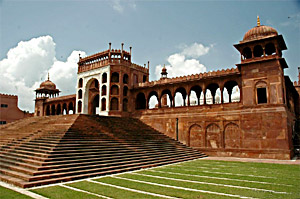Shah Jahan, the Mughal Emperor, was succeeded by Aurangzeb in 1658 AD. The Mughal tradition of building opulent buildings came to a halt with Aurangzeb`s ascend to the throne. Being an orthodox Muslim he restricted his creative urges to mosques and tombs. As a result the sculptures during Aurangzeb era lacked the early Mughal elegance. The monuments built during Aurangzeb`s reign also reflect his basic principles. The Mughal emperor led a life of an ascetic and preferred a simple lifestyle. This simplicity has been transferred on the monuments built by him in Delhi.
 The architecture and sculpture of Moti Masjid (Delhi) was created during his reign. This monument is part of the important buildings in Red Fort. Carved out of white pristine marble this mosque was basically built as a private place for worshipping for the emperor himself. The usual features of Mughal sculpture and architecture are, however, apparent, especially, the Persian influence.
The architecture and sculpture of Moti Masjid (Delhi) was created during his reign. This monument is part of the important buildings in Red Fort. Carved out of white pristine marble this mosque was basically built as a private place for worshipping for the emperor himself. The usual features of Mughal sculpture and architecture are, however, apparent, especially, the Persian influence.
The detailed inlay works define the sculpture of Badshahi Mosque. For a change re sandstone has been used to construct this mosque. It is considered one of the finest architectural specimens from Aurangzeb era. Aurangzeb is also accredited with the construction of Bibi Ka Maqbara. This is one of the sculptures during Aurangzeb era that was created in imitation of the Taj Mahal. But beyond doubt the sculpture of Taj Mahal supersedes it in craftsmanship.



















